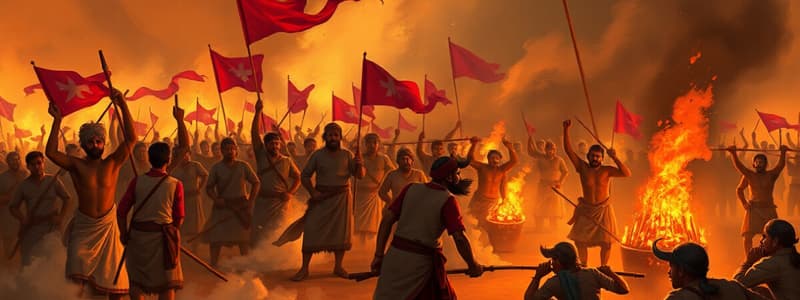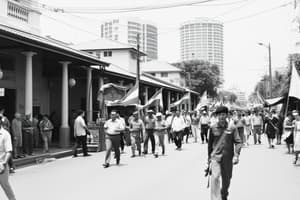Podcast
Questions and Answers
What was a significant consequence of the East India Company’s revenue system in Assam during the 19th century?
What was a significant consequence of the East India Company’s revenue system in Assam during the 19th century?
- Improvement in the living conditions of peasants
- Strengthening of local governance structures
- Implementation of a barter system for tax payments
- Increased tax collection focus disregarding peasant welfare (correct)
Who was a prominent figure involved in the rebellion against British rule in Assam?
Who was a prominent figure involved in the rebellion against British rule in Assam?
- Gomdhar Konwar
- Piyoli Phukan
- Raja Ram Mohan Roy
- Maniram Dewan (correct)
Which of the following events is associated with the anti-British uprising in Assam?
Which of the following events is associated with the anti-British uprising in Assam?
- Revolt of 1857 (correct)
- French Revolution
- Mutiny of 1857 in British India
- American Revolution
What characterized the administrative system prior to British rule regarding revenue collection in Assam?
What characterized the administrative system prior to British rule regarding revenue collection in Assam?
What was a common outcome for uprisings against British rule in Assam during the 19th century?
What was a common outcome for uprisings against British rule in Assam during the 19th century?
What was a major consequence of the British revenue system for Assamese peasants?
What was a major consequence of the British revenue system for Assamese peasants?
What did Anandaram Dhekial Phukan emphasize in his application regarding the British revenue?
What did Anandaram Dhekial Phukan emphasize in his application regarding the British revenue?
Which of the following events occurred in some areas of Kamrup and Darrang in 1851 due to dire circumstances?
Which of the following events occurred in some areas of Kamrup and Darrang in 1851 due to dire circumstances?
What evidence showcases the increase in revenue collection in Assam from 1832-33 to 1882-83?
What evidence showcases the increase in revenue collection in Assam from 1832-33 to 1882-83?
What was a significant change in the economic system imposed by the British in Assam?
What was a significant change in the economic system imposed by the British in Assam?
What is the primary issue with the text in the image?
What is the primary issue with the text in the image?
Which of the following might contribute to the text being unreadable?
Which of the following might contribute to the text being unreadable?
What could potentially improve the readability of the text from the image?
What could potentially improve the readability of the text from the image?
What is the likely cause of the text being difficult to read?
What is the likely cause of the text being difficult to read?
Which of the following statements is true regarding the text?
Which of the following statements is true regarding the text?
Who was the primary instigator of the revolt against the British in Assam?
Who was the primary instigator of the revolt against the British in Assam?
What was Maniram Dewan doing in Calcutta when the mutiny was declared?
What was Maniram Dewan doing in Calcutta when the mutiny was declared?
Who was the Ahom prince decided to lead the soldiers in the revolt?
Who was the Ahom prince decided to lead the soldiers in the revolt?
Which group of people responded to Maniram Dewan's call for revolt?
Which group of people responded to Maniram Dewan's call for revolt?
In collaboration with whom did Maniram Dewan plan to drive the British out of Assam?
In collaboration with whom did Maniram Dewan plan to drive the British out of Assam?
What was one effect of the British establishing tea gardens in Upper Assam?
What was one effect of the British establishing tea gardens in Upper Assam?
How did the British administration impact the cottage industry in Upper Assam?
How did the British administration impact the cottage industry in Upper Assam?
What led to the recruitment of educated Bengalis in the British administration?
What led to the recruitment of educated Bengalis in the British administration?
What was one consequence of the British stopping slavery in Assam in 1843?
What was one consequence of the British stopping slavery in Assam in 1843?
Which leader was NOT associated with the Revolt of 1857?
Which leader was NOT associated with the Revolt of 1857?
What was one of the main effects of British rule on the common people in Assam?
What was one of the main effects of British rule on the common people in Assam?
What method did the British use to exert control over Indian kingdoms?
What method did the British use to exert control over Indian kingdoms?
During which event did the common people of Assam join the revolt against British domination?
During which event did the common people of Assam join the revolt against British domination?
What was a significant consequence of the British tax policies in Assam?
What was a significant consequence of the British tax policies in Assam?
Which leader was NOT associated with the 1857 Revolt in India?
Which leader was NOT associated with the 1857 Revolt in India?
What was a direct action taken by the British government against the lands in Assam?
What was a direct action taken by the British government against the lands in Assam?
How did the introduction of tea gardens impact the common people of Assam?
How did the introduction of tea gardens impact the common people of Assam?
How did the common people perceive the British administration along with Bengali immigrants?
How did the common people perceive the British administration along with Bengali immigrants?
What action did Maniram Dewan take to challenge British rule in Assam?
What action did Maniram Dewan take to challenge British rule in Assam?
What ultimately led to Maniram Dewan's arrest?
What ultimately led to Maniram Dewan's arrest?
What was a primary reason for the failure of the revolt led by Maniram Dewan?
What was a primary reason for the failure of the revolt led by Maniram Dewan?
Who were the primary supporters of Maniram Dewan's revolt?
Who were the primary supporters of Maniram Dewan's revolt?
How did the British respond to Dewan's application to restore the Ahom king?
How did the British respond to Dewan's application to restore the Ahom king?
What was the outcome of the 1857 revolt for the British government in Assam?
What was the outcome of the 1857 revolt for the British government in Assam?
What was a primary reason for the uprisings of the common people in the 19th century Assam?
What was a primary reason for the uprisings of the common people in the 19th century Assam?
What were Raij Mels in Assam during the peasant revolts?
What were Raij Mels in Assam during the peasant revolts?
What burden did the British government impose on the common people after the revolt of 1857?
What burden did the British government impose on the common people after the revolt of 1857?
Which factor played a role in the common people's suffering during the British rule in Assam?
Which factor played a role in the common people's suffering during the British rule in Assam?
What was one of the main reasons for the increase in taxes in Assam between 1854 and 1870?
What was one of the main reasons for the increase in taxes in Assam between 1854 and 1870?
Which tax was imposed in Assam in 1860 specifically for the use of grazing land?
Which tax was imposed in Assam in 1860 specifically for the use of grazing land?
What role did the Raij Mel play during the peasant revolts in Assam?
What role did the Raij Mel play during the peasant revolts in Assam?
What was a consequence of the British taxes imposed on the peasants in Assam?
What was a consequence of the British taxes imposed on the peasants in Assam?
What action did the British government take concerning rivers in Assam where gold and fish were found?
What action did the British government take concerning rivers in Assam where gold and fish were found?
What position did Maniram Dewan hold when he initially started working with the British government?
What position did Maniram Dewan hold when he initially started working with the British government?
Why did Maniram Dewan resign from his position at the Assam Tea Company?
Why did Maniram Dewan resign from his position at the Assam Tea Company?
What realization did Maniram Dewan come to regarding the British domination in Assam?
What realization did Maniram Dewan come to regarding the British domination in Assam?
What was a significant request made by Maniram Dewan to Chief Justice Moffat Mills?
What was a significant request made by Maniram Dewan to Chief Justice Moffat Mills?
What was one of the main reasons for the failure of Maniram Dewan's rebellion?
What was one of the main reasons for the failure of Maniram Dewan's rebellion?
Why did Maniram Dewan refuse the pension offered by the British?
Why did Maniram Dewan refuse the pension offered by the British?
What tragic event happened to Maniram Dewan on 26 February 1858?
What tragic event happened to Maniram Dewan on 26 February 1858?
What hindered Maniram Dewan's efforts to ignite a rebellion in Assam?
What hindered Maniram Dewan's efforts to ignite a rebellion in Assam?
Which of the following best explains the impact of Captain Holroyd on Maniram Dewan's life?
Which of the following best explains the impact of Captain Holroyd on Maniram Dewan's life?
What was the outcome of Maniram Dewan's correspondence with the English government?
What was the outcome of Maniram Dewan's correspondence with the English government?
Flashcards are hidden until you start studying
Study Notes
Anti-British Uprising in Assam
- By the 1830s and 1840s, the East India Company solidified its control over Assam, effectively suppressing local uprisings.
- Significant rebellions included those led by Gomdhar Konwar and Piyoli Phukan, both of which failed against British authority.
- The introduction of a revenue collection system focused heavily on taxes without consideration for the struggles of local peasants.
Assamese Peasants and the British Revenue System
- The British revenue system transitioned Assam to a cash economy, fostering discontent among peasants.
- Mahajans (moneylenders) emerged, exploiting villagers with exorbitant interest rates for loans needed to pay land revenue.
- Revenue statistics showed dramatic increases in tax collection, highlighting the growing financial burden on peasants:
- Kamrup: From ₹1,10,181 (1832-33) to ₹2,95,996 (1882-83)
- Nowgong: From ₹41,306 (1832-33) to ₹1,57,795 (1882-83)
Economic Impact on Assamese Society
- High land revenue led to severe hardships, pushing vulnerable families into debt and starvation.
- In 1851, desperate parents in Kamrup and Darrang reportedly sold their children for food due to famine.
- The British administration neglected agricultural development, worsening conditions during severe weather.
Upper Assam and the 19th Century
- Tea gardens were established by the British, exempt from revenue, further burdening local peasants with taxation.
- The introduction of foreign textiles diminished the Ahom aristocracy’s control over traditional industries.
- Lack of modern education marginalized the Ahom elite, resulting in British recruitment of educated Bengalis for administrative roles.
The Revolt of 1857
- The 1857 revolt marked a crucial turning point in Indian resistance against British rule.
- Fueled by discontent with British policies, it included figures such as Emperor Bahadur Shah Zafar and Rani Lakshmibai.
- The mutiny resonated in Assam, contributing to local resistance against oppressive governance.
Efforts of Maniram Dewan
- Maniram Dewan, originally a high-ranking official under the British, sought to restore the Ahom monarchy amid growing resentment.
- After experiencing personal and political disenfranchisement, Dewan orchestrated plans for a rebellion.
- He was arrested in February 1858, along with several conspirators who supported his vision for an independent Assam.
Causes of the Failure of the Rebellion
- Dewan's movement failed due to limited popular support and lack of coordinated efforts across Assam.
- Arrests of key figures and poor timing hindered the rebellion’s potential.
Significance of the Revolt of 1857 in Assam
- The revolt initiated a historical moment for Assam, marking its inclusion in significant nationwide resistance against British dominion.
- Subsequent peasant revolts in Assam after 1861 gained momentum as discontent grew over economic exploitation.
Rise of Peasant Revolts
- The transition of power from the East India Company to the British government resulted in increased taxes to address financial deficits.
- The British government's failure to assist the struggling peasantry during disasters intensified grievances, leading to uprisings.
- Economic mismanagement and natural calamities created fertile ground for popular discontent.
Raij Mel Movement
- Raij Mel (People's Associations) played a vital role in organizing peasant revolts, focusing on political awareness and education.
- These assemblies were grassroots movements, unaligned with specific political parties but were influential in mobilizing the common people.
Conclusion
- The anti-British uprisings in Assam were characterized by significant socio-economic changes enforced by the British and the resultant resistance of the Assamese people, culminating in pivotal events like the Revolt of 1857 and subsequent peasant revolts.
Studying That Suits You
Use AI to generate personalized quizzes and flashcards to suit your learning preferences.




